In Elizabethan times, the nearby gatehouse of the former Priory of St John served as the office of the Master of the Revels, who was responsible for licensing plays, masques and other entertainment for the queen. A masque was a lavish drama with music and dancing, written by the leading poets and playwrights of the day. It was performed by masked figures and had an unusual name, like the masked haunt.
Framed drawings and text about The Masque Haunt.
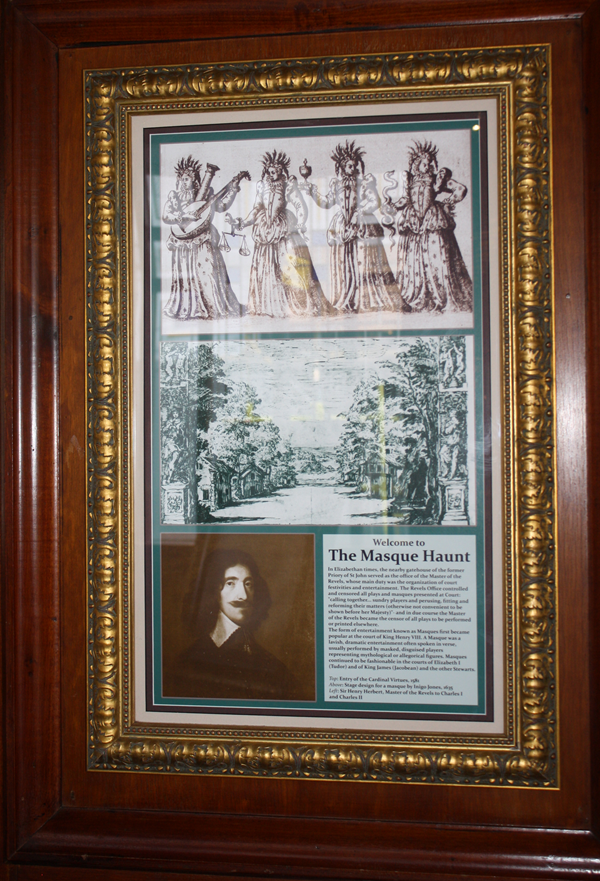
The text reads: In Elizabethan times, the nearby gatehouse of the former priory of St John served as the office of the Master of the Revels, whose main duty was the organization of court festivities and entertainment. The Revels Office controlled and censored all plays and masques presented at Court: “calling together… sundry players and perusing, fitting and reforming their matters (otherwise not convenient to be shown before her majesty)” – and in due course the master of the revels became the censor of all plays to be performed or printed elsewhere.
The form of entertainment known as Masques first became popular at the court of King Henry VIII. A Masque was a lavish, dramatic entertainment often spoken in verse, usually performed by masked, disguised players representing mythological or allegorical figures, Masques continued to be fashionable in the courts of Elizabeth I (Tudor) and King James (Jacobean) and the other Stewarts.
Top: Entry of the Cardinal Virtues 1581
Above: Stage design for masque by Inigo Jones, 1635
Left: Sir Henry Herbert, Master of the Revels to Charles I and Charles II.
Framed drawings and text about Richard Burbage and Richard Tarlton.
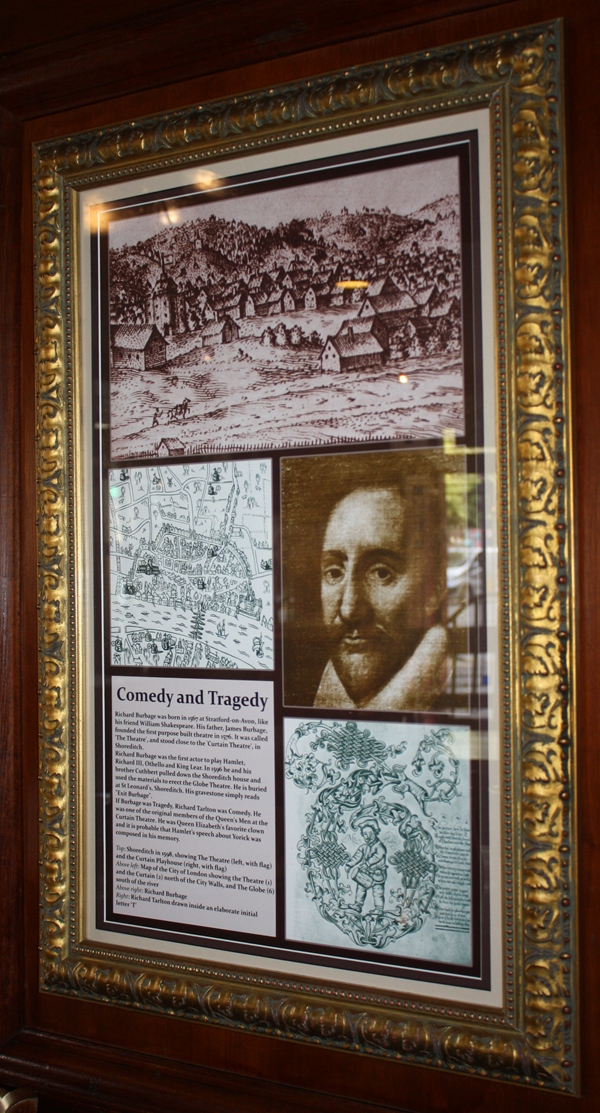
The text reads: Richard Burbage was born in 1567 at Stratford-on-Avon, Like his friend William Shakespeare. His father, James Burbage, founded the first purpose built theatre in 1576. It was called “The Theatre”, and stood close to the “curtain Theatre”, in Shoreditch.
Richard Burbage was the first actor to play Hamlet, Richard III, Othello and King Lear. In 1596 he and his brother Cuthbert pulled down the Shoreditch. His gravestone simply reads “Exit Burbage”.
If Burbage was Tragedy, Richard Tarlton was Comedy. He was one of the original members of the Queen’s Men at the Curtain Theatre. He was Queen Elizabeth’s favourite clown and it is probable that Hamlet’s speech about Yorick was composed in his memory.
Top: Shoreditch in 1598, Showing Theatre (left, with flag) and the Curtain Playhouse (right, with flag)
Above left: Map of the city of London showing the Theatre (1) and the Curtain (2) north of the City Walls, and the Globe (6) south of the river
Above right: Richard Burbage
Right: Richard Tarlton drawn inside an elaborate initial letter ‘T’.
Framed drawings, prints and text about Jane Shore.
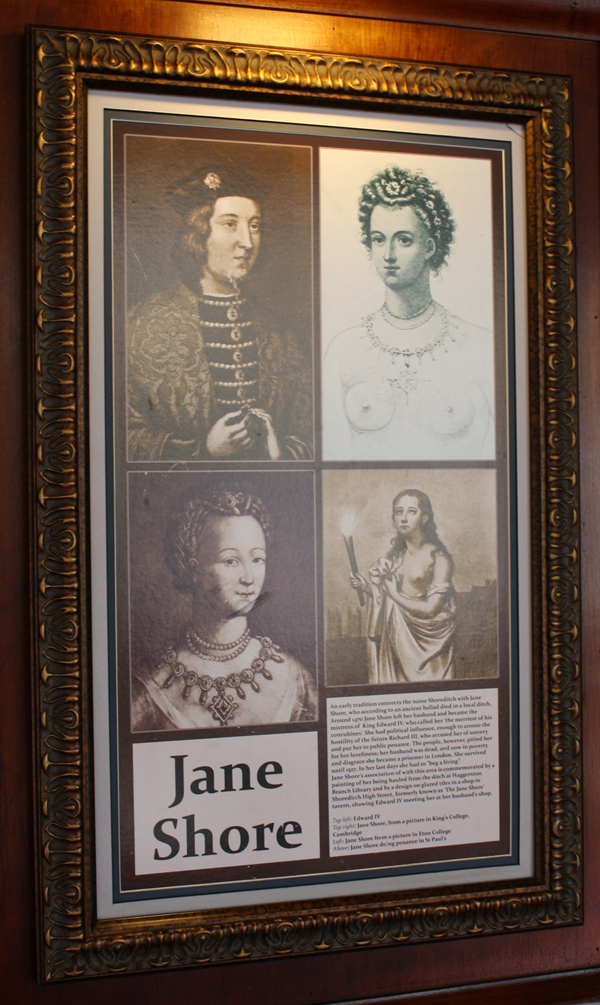
The text reads: An early tradition connects the name Shoreditch with Jane Shore, Who according to an ancient ballad died in a local ditch. Around 1470 Jane Shore left her husband and became the mistress of King Edward IV, who called her ‘the merriest of his concubines’. She had political influence, enough to arouse the hostility of the future Richard III, who accused her of sorcery and put her to public penance. The people, however, pitied her for her loveliness; her husband was dead, and now in poverty and disgrace she became a prisoner in London. She survived until 1527. In her last days she had to “beg a living”.
Jane Shore’s association of with this area is commemorated by a painting of her being hauled from a ditch at Haggerston Branch Library and by design on glazed tiles in a shop in Shoreditch high street, formerly known as ‘The Jane Shore’ tavern, showing Edward IV meeting her at her husband’s shop.
Top left: Edward IV
Top right: Jane Shore, from a picture in Kings College, Cambridge
Left: Jane Shore from a picture in Eton College
Above: Jane Shore doing Penance in St Paul’s
Framed photographs and text about Barbara Windsor.
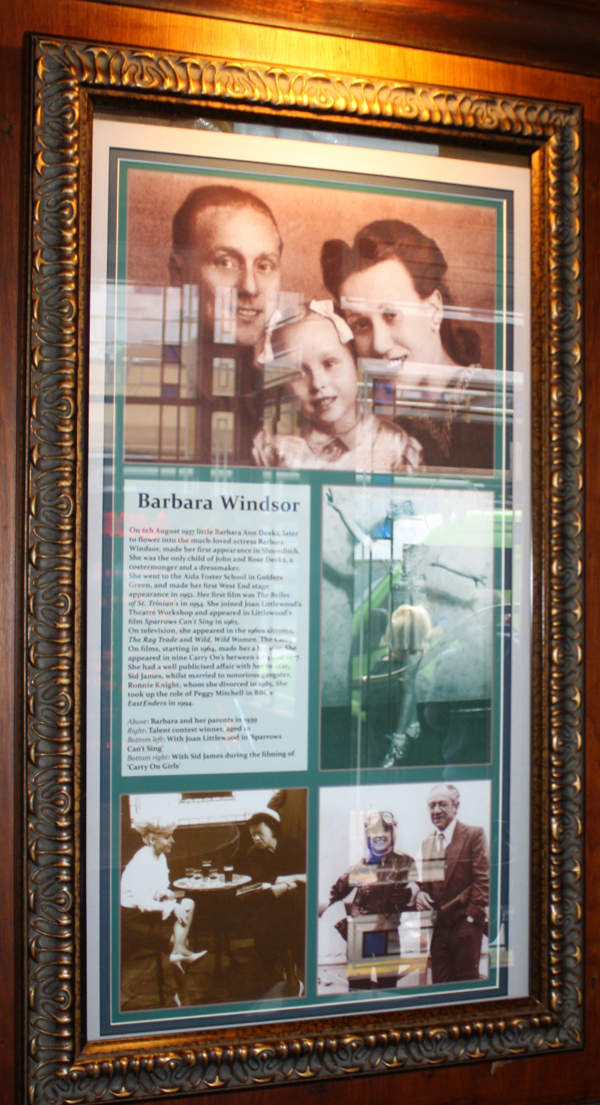
The text reads: On the 6th August 1937 little Barbara Ann Decks, later to flower into the much-loved actress Barbra Windsor, made her first appearance in Shoreditch. She was the only child of John and Rose Decks, a costermonger and a dress maker.
She went to the Aida Foster School in Golders Green, and made her first West End stage appearance in 1952. Her first film was The Belles of St. Trinian’s in 1952. She joined Joan Littlewood’s Theatre Workshop and appeared in Littlewood’s film Sparrows can’t Sing in 1963.
On television, she appeared in the 1960s sitcoms The Rag Trade and Wild, Wild Women. The Carry On films, starting in 1964, made her a big star. She appeared in nine Carry On’s between 1964 and 1977. She had a well-publicised affair with her co-star, Sid James, whilst married to notorious gangster, Ronnie Knight, whom she divorced in 1985. She took up the role of Peggy Mitchell in BBC’s EastEnders In 1994.
Above: Barbara and her parents in 1939
Right: Talent contest winner, aged 10
Bottom left: With John Littlewood in ‘Sparrows Can’t sing’
Bottom right: With Sid James during the filming of ‘Carry On Girls’
Framed drawings and text about John Wesley.
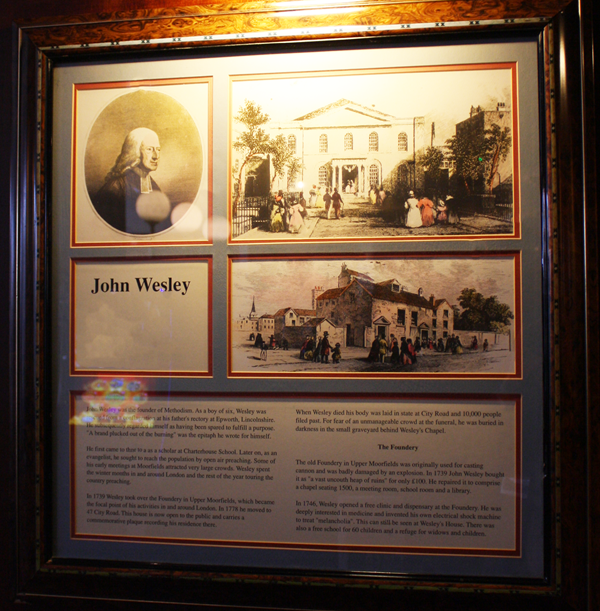
The text reads: John Wesley was the founder of Methodism. As a boy of six, Wesley was rescued from conflagration at his father’s rectory at Epworth, Lincolnshire. He subsequently regarded himself as having been spared to fulfil a purpose. “A brand plucked out of the burning” was the epitaph he wrote for himself.
He first came to this area as a scholar at Charterhouse School. Later On, as an evangelist, he sought to reach the population by open air preaching. Some of the winter months in and around London and the rest of the year touring the country preaching.
In 1739 Wesley took over the Foundery in Upper Moorfields, which became the focal point of his activities in and around London. In 1778 he moved to 47 City Road. This house is now open to the public and carries a commemorative plaque recording his residence there.
When Wesley Died his body was laid in state at City Road and 10,000 people filed past. For fear of an unmanageable crowd at the funeral, he was buried in darkness in the small graveyard behind Wesley’s Chapel.
The old Foundery in Upper Moorfields was originally used for casting cannon and was badly damaged by an explosion. In 1739 John Wesley bought it as “a vast uncouth heap of ruins” for only £100. He repaired it to comprise a chapel seating 1500, a meeting room, schoolroom and a library.
In 1746, Wesley opened a free clinic and dispensary at the Foundery. He was deeply interested in medicine and invented his own electrical shock machine to treat “melancholia”. This can still be seen at Wesley’s House. There was also a free school for 60 children and a refuge for widows and children.
A framed drawing and text about John Bunyan.
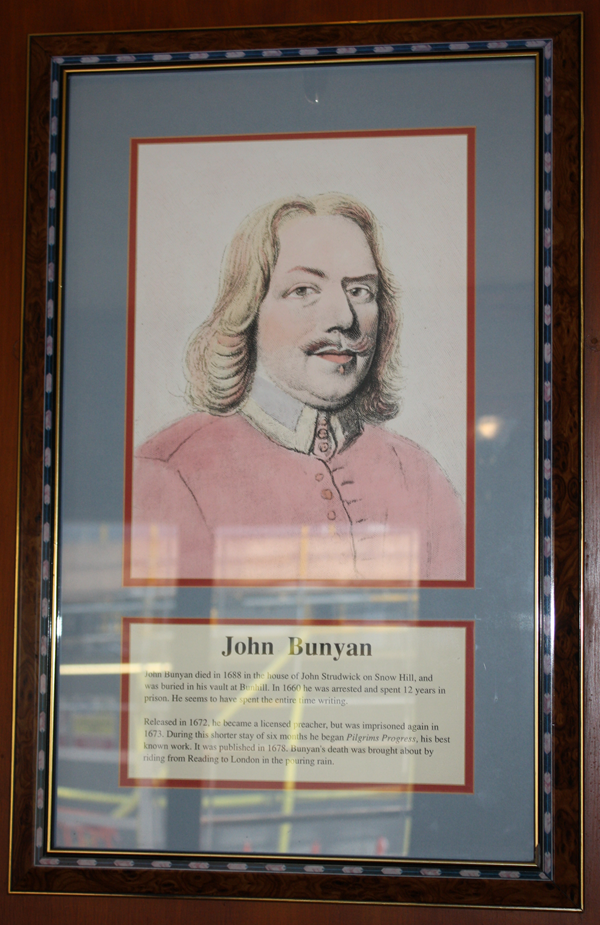
The text reads: John Bunyan died in 1688 in the house of John Strudwick on Show Hill, and was buried in his vault at Bunhill. In 1660 he was arrested and spent 12 years in prison. He seems to have spent the entire time writing
Released in 1672, he became a licensed preacher, but was imprisoned again in 1673. During this shorter stay of six months he began Pilgrims Progress, His best riding from reading to London in the pouring rain.
A framed print and text about Daniel Defoe.
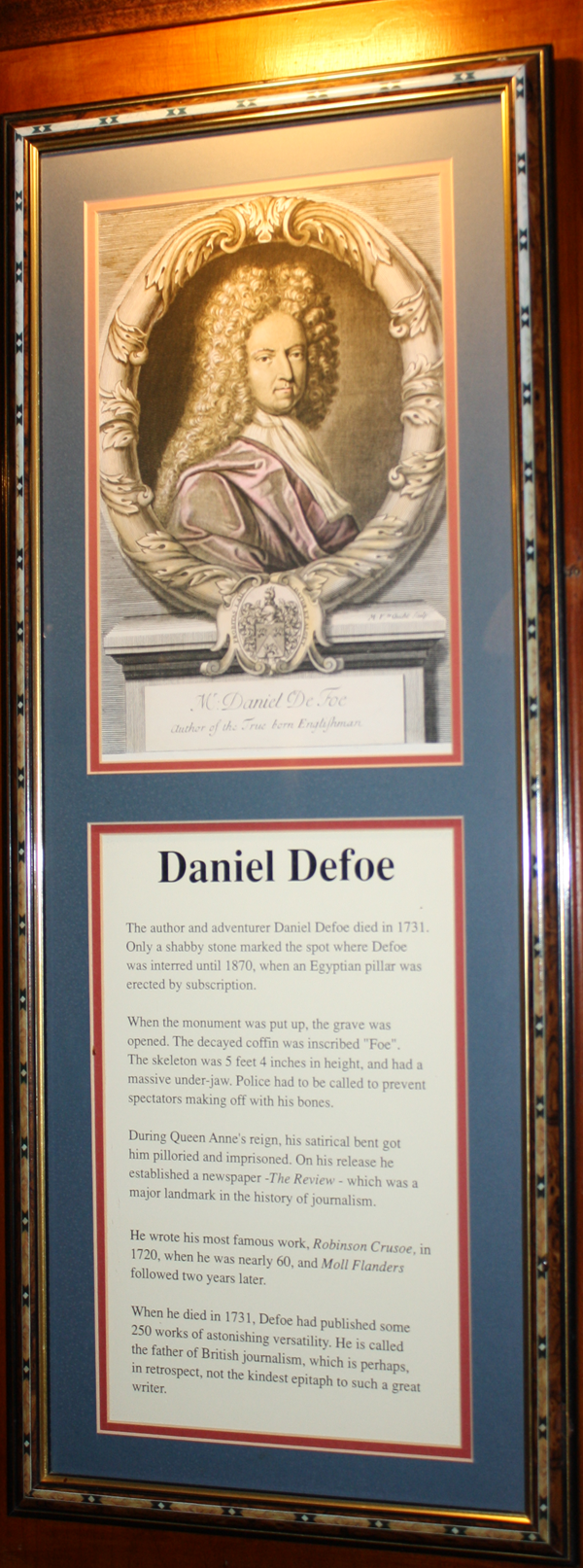
The text reads: The author and adventurer Daniel Defoe died in 1731. Only a Shabby stone marked the spot where Defoe was interred until 1870, when an Egyptian pillar was erected by subscription.
When the monument was put up, the grave was opened. The decayed coffin was inscribed “Foe”. The skeleton was 5 feet 4 inches in height, and had a massive under-jaw. Police had to be called to stop spectators making off with his bones.
During Queen Anne’s reign, his satirical bent got him pilloried and imprisoned. On his release he established a newspaper – The Review – which was a major landmark in the history of journalism.
He wrote his most famous work, Robinson Crusoe, in 1720, when he was nearly 60, and Moll Flanders followed two years later.
When he died in 1731, Defoe had published some 250 works of astonishing versatility. He is called the father of British journalism, which is perhaps, in retrospect, not the kindest epitaph to such a great writer.
Framed drawings, prints and text about the New Artillery Ground.
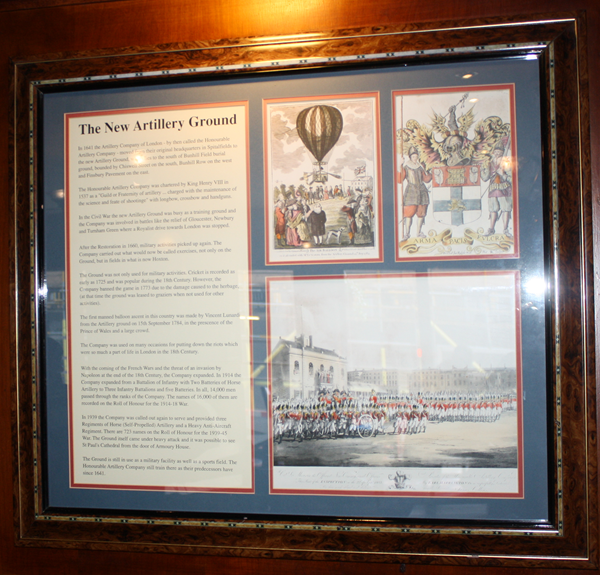
The text reads: In 1641 the Artillery Company of London – by then called the Honourable Artillery Company – moved from their original headquarters in Spitalfields to the new Artillery Ground, which lies to the south of Bunhill Field burial ground, bounded by Chiswell Street on the south, Bunhill Row on the west and Finsbury Pavement on the east.
The Honourable Artillery Company was chartered by King Henry VIII in 1537 as a “Guide or Fraternity of artillery … charged with the maintenance of the science and feate of shooting” with longbow, crossbow and handguns.
In the Civil War the New Artillery Ground was busy as a training ground and the company was involved in battles like the relief of Gloucester, Newbury and Turnham Green where a royalist drive towards London was stopped
After the Restoration in 1660, military activities picked up again. The Company carried out what would now be called exercises, not only on the Ground, but in fields in what is now Hoxton.
The Ground was not only used for military activities. Cricket is recorded as early as 1725 and was popular during the 18th Century. However, the company banned the game in 1773 due to the damage caused to the herbage, (at the time the ground was leased to graziers when not used for other activities).
The first manned balloon ascent in this country was made by Vincent Lunardi from the Artillery ground on 15th September 1784, in the presence of the Prince of Wales and a large crowd.
The Company was used on many occasions for putting down the riots which were so much a part of life in London in the 18th Century
With the coming of the French Wars and the threat of an invasion by Napoleon at the end of the 18th Century, the company expanded. In 1914 the Company expanded from a Battalion of Infantry with Two Batteries of Horse Artillery to Three Infantry Battalions and five Batteries. In all, 14,000 men passed through the ranks of the Company. The names of 16,000 of them are recorded on the Roll of Honour for the 1914-18 War.
In 1939 the company was called out again to serve and provide three Regiments of Horse (Self-Propelled) Artillery and a Heavy Anti-Aircraft Regiments. There are 723 names on the Roll of Honour for the 1939-45 War. The Ground itself came under heavy attack and it was possible to see St Pauls Cathedral from the door of the Armoury House.
The Ground is still in use as military facility as well as a sports field. The Honourable Artillery Company still train there as their predecessors have since 1641.
Framed drawing depicting a theatrical performance.
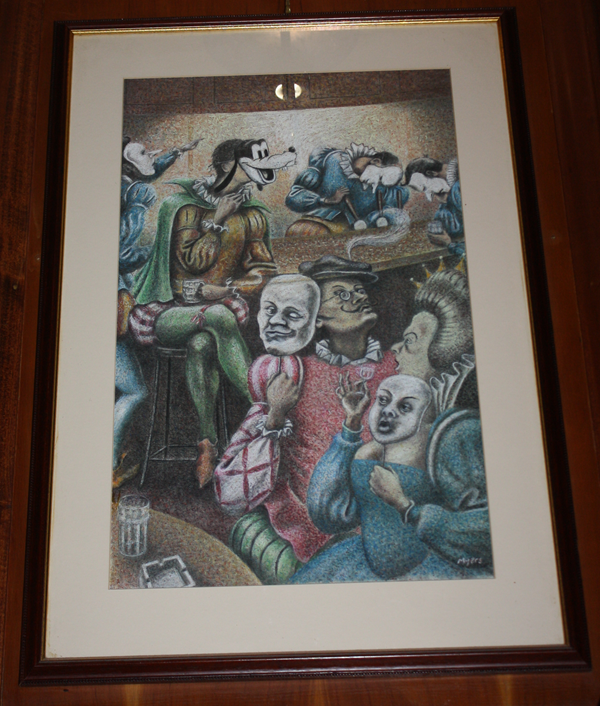
Framed photographs of the Alexandra Trust’s dining room, City Road, London.
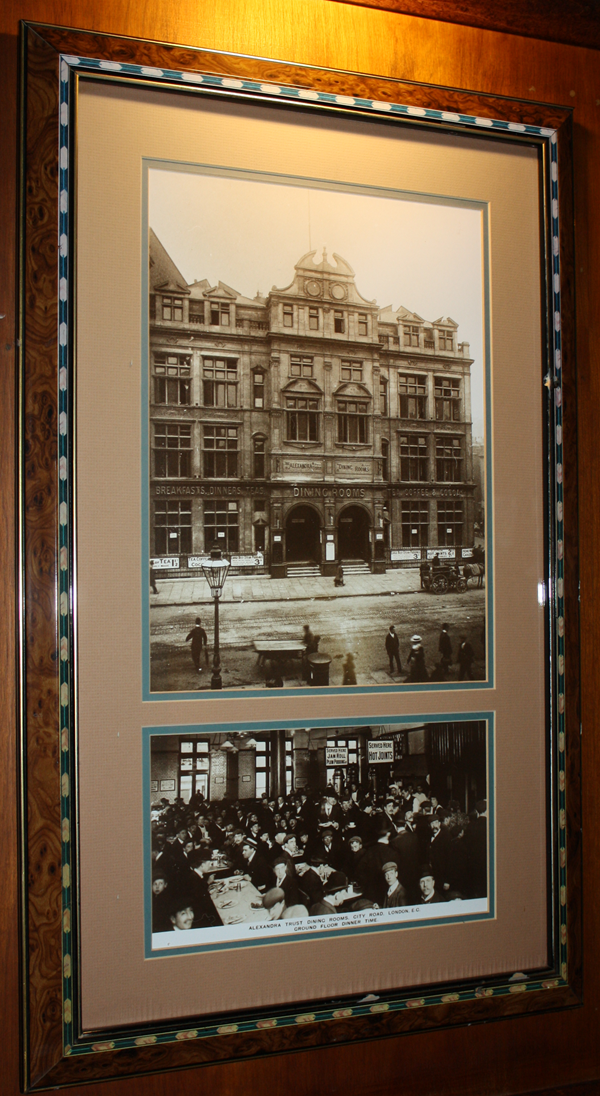
Framed photographs of Old Street c.1905.
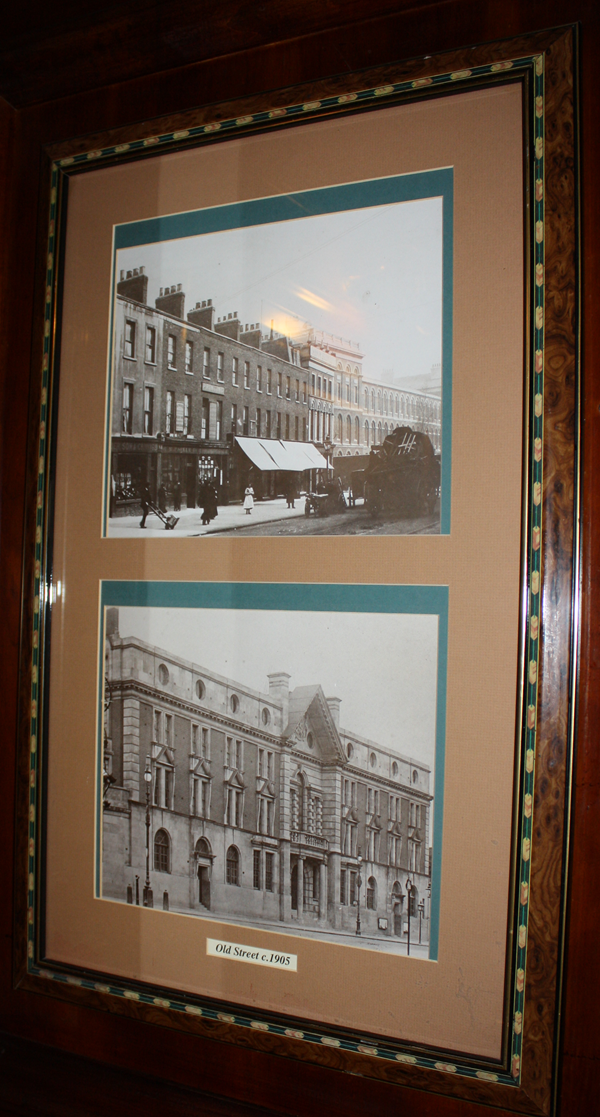
A framed photograph of Old Street c.1905.
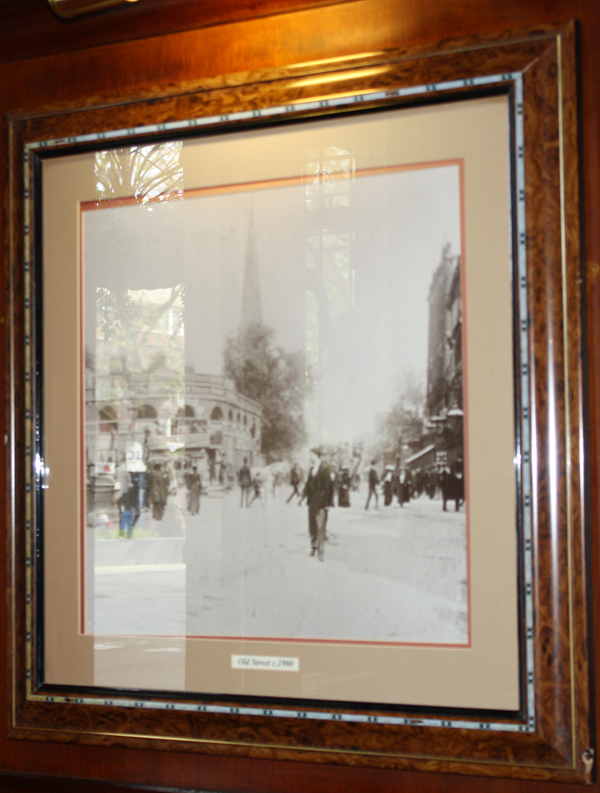
Framed photographs of street sellers, 1905.
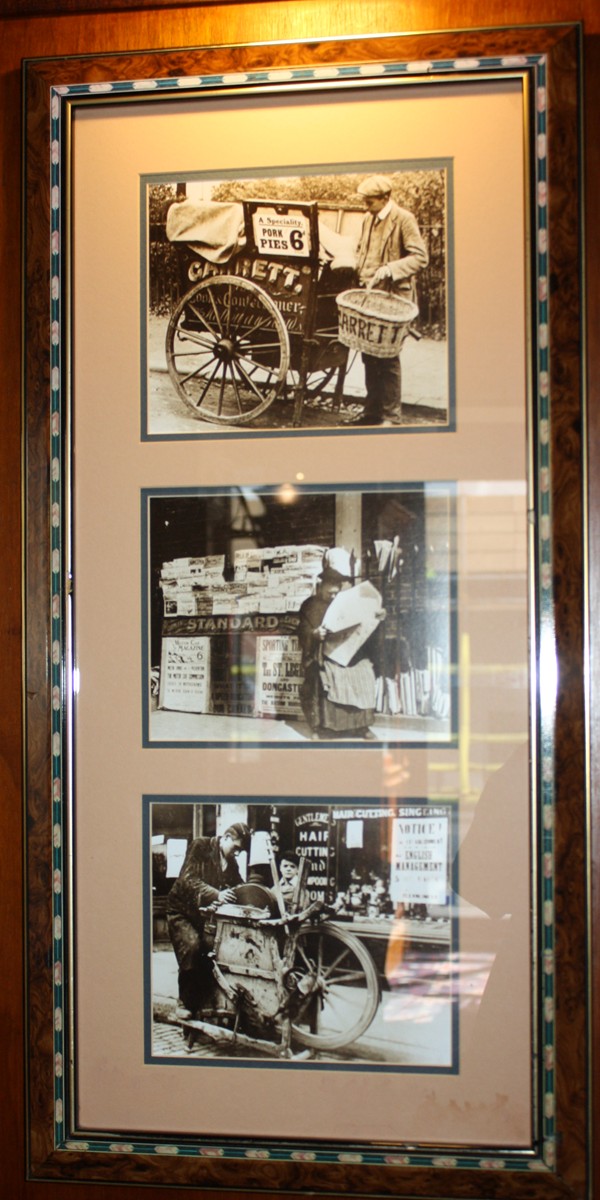
If you have information on the history of this pub, then we’d like you to share it with us. Please e-mail all information to: pubhistories@jdwetherspoon.co.uk